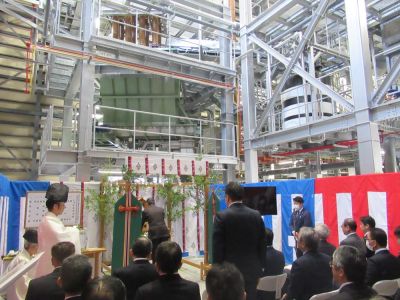2024.05.08
News
B-DASH Project: Full-scale Kiln Completed in Kesennuma City, Miyagi
The Joint Research Group that includes the Chuo University Research and Development Initiative “Decarbonisation, Digital Transformation, and Advancement of Sewage and Sludge Treatment Unit” (Unit leader: Professor of the Faculty of Science and Engineering, YAMAMURA Hiroshi) has completed a real-scale kiln in Kesennuma city, Miyagi Prefecture, which burns sewage and sludge at ultra-high temperature for carbonisation. The facility was established as the B-DASH Project (Breakthrough by Dynamic Approach in Sewage High Technology Project) organised by the Ministry of Land, Infrastructure, Transport, and Tourism.
The Inauguration Ceremony was held on March 19th, 2024, with an attendance of many parties concerned from the joint research entities, the Ministry of Land, Infrastructure, Transport, and Tourism, and Kesennuma City. An interview was conducted by local media showing the high expectations of the locals towards the kiln.
<Project Summary>
● Research Title: “Demonstration project of ultra-high temperature carbonisation technology that contributes to the generation of high value added sludge and low carbon society”
● Joint Research Entities: DAIDO STEEL, TETSUGEN CORPORATION, GREEN TEC CORPORATION, Chuo University and Kesennuma City
● Practice Technology: In light of the realisation of adding a high value to wastewater and sludge by converting them into active carbons, etc., this research demonstrates the manufacturing of active carbons alternate materials using an energy-saving ultra-high temperature carbonisation system with increased thermal efficiency, reduced greenhouse gas release, and cost reduction.
0.23 billion cubic metres of sludge, which is 185 times larger than the Tokyo Dome area, is produced annually and is disposed of after being reduced and stabilised. Recently, a method to effectively use carbon, nitrogen and phosphorus contained in sludge has been developed. Ultra-high temperature carbonisation technology, which will be demonstrated in this research, will enable the conversion of sludge into high-function active carbon with an advanced porous structure along with the reduction of sodium and heavy metals contained in the sludge. This generated activated carbon will be used in the house to remove smells and hydrogen sulfides gas that arise in sewage facilities and will be distributed or sold to citizens or local governments as a highly functional ameliorant. Research is gaining attention as a new technology that will pave the way to carbon neutrality in medium to small cities, as well as a technology that stimulates the local economy.


